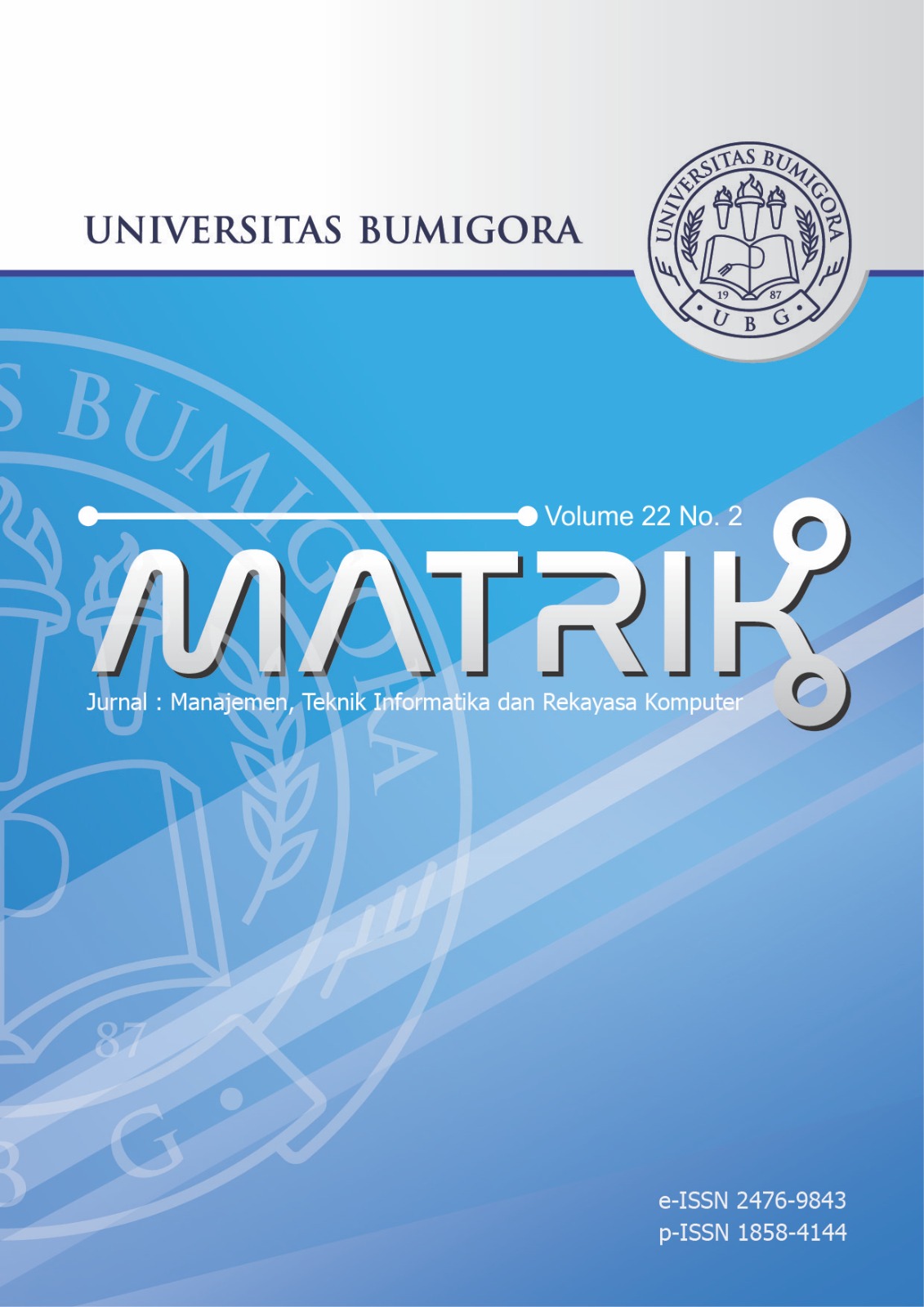Customer Segmentation with RFM Model using Fuzzy C-Means and Genetic Programming
Abstract
One of the strategies a company uses to retain its customers is Customer Relationship Management (CRM). CRM manages interactions and supports business strategies to build mutually beneficial relationships between companies and customers. The utilization of information technology, such as data mining used to manage the data, is critical in order to be able to find out patterns made by customers when processing transactions. Clustering techniques are possible in data mining to find out the patterns generated from customer transaction data. Fuzzy C-Means (FCM) is one of the best-known and most widely used fuzzy grouping methods. The iteration process is carried out to determine which data is in the right cluster based on the objective function. The local minimum is the condition where the resulting value is not the lowest value from the solution set. This research aims to solve the minimum local problem in the FCM algorithm using Genetic Programming (GP), which is one of the evolution-based algorithms to produce better data clusters. The result of the research is to compare the application of fuzzy c-means (FCM) and genetic programming fuzzy c-means (GP-FCM) for customer segmentation applied to the Cahaya Estetika clinic dataset. The test results of the GP-FCM yielded an objective function of 20.3091, while for the FCM algorithm, it was 32.44741. Furthermore, evaluating cluster validity using Partition Coefficient (PC), Classification Entropy (CE), and Silhouette Index proves that the results of cluster quality from gp-fcm are more optimal than fcm. The results of this study indicate that the application of genetic programming in the fuzzy c-means algorithm produces more optimal cluster quality than the fuzzy c-means algorithm.
Downloads
References
Segmentation,” Journal of Retailing and Consumer Services, vol. 61, no. April, pp. 1–9, 2021.
[2] V. Guerola-Navarro, H. Gil-Gomez, R. Oltra-Badenes, and J. Sendra-Garc´ıa, “Customer Relationship Management and Its
Impact on Innovation: A Literature Review,” Journal of Business Research, vol. 129, no. March, pp. 83–87, 2021.
[3] Z. Soltani, B. Zareie, F. S. Milani, and N. J. Navimipour, “The Impact of the Customer Relationship Management on the
Organization Performance,” Journal of High Technology Management Research, vol. 29, no. 2, pp. 237–246, 2018.
[4] S. Monalisa and A. S. Roza, “Penerapan Association Rules untuk Elemen Cross Selling Pada Sistem Informasi Customer
Development,” Techno.Com, vol. 20, no. 3, pp. 420–429, 2021.
[5] S. Tripathi, A. Bhardwaj, and P. E, “Approaches to Clustering in Customer Segmentation,” International Journal of Engineering
& Technology, vol. 7, no. 3.12, p. 802, 2018.
[6] P. P. Pramono, I. Surjandari, and E. Laoh, “Estimating Customer Segmentation Based on Customer Lifetime Value Using Two-
Stage Clustering Method,” in 2019 16th International Conference on Service Systems and Service Management, ICSSSM 2019.
IEEE, 2019, pp. 1–5.
[7] N. G. A. Dasriani, M. Mayadi, and A. Anggrawan, “Klasterisasi Lokasi Promosi PMB Dengan Fuzzy C-means Masa Pandemi
Covid 19,” MATRIK : Jurnal Manajemen, Teknik Informatika dan Rekayasa Komputer, vol. 21, no. 2, pp. 327–336, 2022.
[8] V. Kumar and W. Reinartz, Customer Relationship Management Concept, Strategy and Tools, third edit ed. Springer Texts in
Business and Economics (STBE), 2018.
[9] A. M. Pater, S. Vari-Kakas, O. Poszet, and I. G. Pintea, “Segmenting Users of an Online Store Using Data Mining Techniques,”
in 2019 15th International Conference on Engineering of Modern Electric Systems, EMES 2019, 2019, pp. 205–208.
[10] A. M. Anter, A. E. Hassenian, and D. Oliva, “An Improved Fast Fuzzy C-Means Using Crow Search Optimization Algorithm
for Crop Identification in Agricultural,” Expert Systems with Applications, vol. 118, no. March, pp. 340–354, mar 2019.
[11] A. Seal, A. Karlekar, O. Krejcar, and C. Gonzalo-Martin, “Fuzzy C-Means Clustering Using Jeffreys-Divergence Based Similarity
Measure,” Applied Soft Computing, vol. 88, no. March, pp. 1–11, mar 2020.
[12] D. B. Saputra and E. Riksakomara, “Implementasi Fuzzy C-Means dan Model RFM untuk Segmentasi Pelanggan (Studi Kasus
: PT. XYZ),” Jurnal Teknik ITS, vol. 7, no. 1, pp. 1–6, 2018.
[13] M. T. Dharmawan, N. Y. Setiawan, and F. A. Bachtiar, “Segmentasi Pelanggan Menggunakan Metode Fuzzy C-Means Clustering
Berdasarkan LRFM Model Pada Toko Sepatu (Studi Kasus: Ride Inc Kota Malang),” Jurnal Pengembangan Teknologi
Informasi dan Ilmu Komputer, vol. 3, no. 2, pp. 1978–1985, 2019.
[14] S. S. Prasetyo, M. Mustafid, and A. R. Hakim, “Penerapan Fuzzy C-Means Kluster untuk Segmentasi Pelanggan E-Commerce
Dengan Metode Recency Frequency Monetary (RFM),” Jurnal Gaussian, vol. 9, no. 4, pp. 421–433, 2020.
[15] Faza Adhzima, Yandra Arkeman, and Irman Hermadi, “The Clustering Rice Plant Diseases Using Fuzzy C-Means and Genetic
Algorithm,” Jurnal RESTI (Rekayasa Sistem dan Teknologi Informasi), vol. 6, no. 2, pp. 240–245, 2022.
[16] H. Andersen, A. Lensen, and B. Xue, “Genetic Programming for Evolving Similarity Functions Tailored to Clustering Algorithms,”
in 2021 IEEE Congress on Evolutionary Computation, CEC 2021 - Proceedings, 2021, pp. 688–695.
[17] R. Syelly, I. Laksmana, T. Komputer, S. Tinggi Teknologi Payakumbuh, and J. Khatib Sulaiman, “Rancang Bangun Sistem
Pakar Model Identifikasi untuk Klasifikasi Varietas Unggul Tanaman Gambir Menggunakan Genetic Programming,” AGRIEKSTENSIA:
Jurnal Penelitian Terapan Bidang Pertanian, vol. 19, no. 1, pp. 38–48, jul 2020.
[18] H. Hairani, D. Susilowati, I. Puji Lestari, K. Marzuki, and L. Z. A. Mardedi, “Segmentasi Lokasi Promosi Penerimaan Mahasiswa
Baru Menggunakan Metode RFM dan K-Means Clustering,” MATRIK : Jurnal Manajemen, Teknik Informatika dan
Rekayasa Komputer, vol. 21, no. 2, pp. 275–282, 2022.
[19] N. Puspitasari, J. A. Widians, and N. B. Setiawan, “Customer Segmentation Using Bisecting K-means Algorithm Based on
Recency, Frequency, and Monetary (RFM) Model,” Jurnal Teknologi dan Sistem Komputer, vol. 8, no. 2, pp. 78–83, 2020.
[20] S. T. Wierzcho´n and M. A. Kłopotek, “Introduction in: Modern Algorithms of Cluster Analysis,” in Studies in Big Data, 2018,
vol. 34, pp. 1–7.
[21] B. Tran, B. Xue, and M. Zhang, “Genetic Programming for Multiple-Feature Construction on High-Dimensional Classification,”
Pattern Recognition, vol. 93, no. September, pp. 404–417, sep 2019.

This work is licensed under a Creative Commons Attribution-ShareAlike 4.0 International License.


.png)













